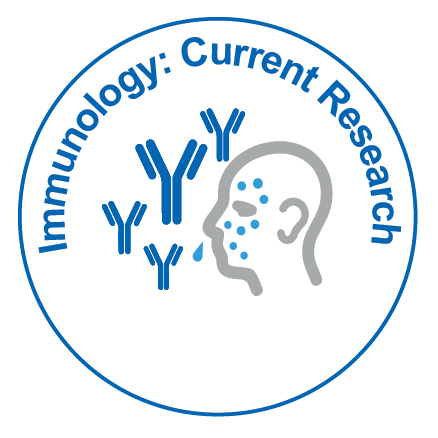Understanding Adaptive Immunity: How Our Immune System Learns and Remembers
Received: 03-Mar-2025 / Manuscript No. icr-25-166419 / Editor assigned: 05-Mar-2025 / PreQC No. icr-25-166419 (PQ) / Reviewed: 19-Mar-2025 / QC No. icr-25-166419 / Revised: 24-Mar-2025 / Manuscript No. icr-25-166419 (R) / Accepted Date: 30-Mar-2025 / Published Date: 30-Mar-2025
Abstract
Adaptive immunity is a specialized branch of the immune system that provides targeted and long-lasting protection against pathogens by learning to recognize specific antigens. Unlike the innate immune system, adaptive immunity tailors its response to particular invaders and retains a memory of past encounters, enabling faster and more effective responses upon subsequent exposures. This article explores the fundamental components of adaptive immunity, including the roles of T cells and B cells, the processes of antigen recognition, and the development of immunological memory. Additionally, it highlights the significance of adaptive immunity in vaccination strategies and its critical role in maintaining health and combating infectious diseases. Understanding how the immune system learns and remembers is essential for advancing medical interventions and improving disease prevention.
Keywords
Adaptive immunity; Immune system; Antigen recognition; Immunological memory; Vaccination; Pathogen defense; Immune response; Immunology
Introduction
The human immune system is a complex network designed to protect the body from harmful pathogens such as bacteria, viruses, and fungi. Among its two primary arms—the innate and adaptive immune systems—adaptive immunity stands out for its remarkable ability to recognize specific threats, mount a targeted response, and remember those threats for future protection [1]. This ability to learn and remember distinguishes adaptive immunity from the more generalized innate immune response and forms the foundation for effective long-term immunity [2],[3]. Adaptive immunity involves highly specialized cells and mechanisms that adapt to new challenges, making it a crucial component in fighting infections and enabling the success of vaccines. By understanding how adaptive immunity functions through the recognition of antigens, activation of immune cells, and formation of immunological memory, we gain insight into how the body defends itself with precision and resilience [4]. This article delves into the key features of adaptive immunity, illuminating the processes that empower our immune system to learn from past encounters and protect us throughout life.
Discussion
Adaptive immunity represents a sophisticated and dynamic defense mechanism that goes beyond the immediate responses of the innate immune system. Central to this process are lymphocytes—T cells and B cells—which possess unique receptors capable of recognizing a vast array of antigens [5]. When these cells encounter a specific antigen, they become activated, proliferate, and differentiate into effector cells that directly combat the pathogen. Simultaneously, a subset of these cells develops into memory cells that persist long after the initial infection has resolved [6]. The generation of immunological memory is a hallmark of adaptive immunity, providing enhanced protection upon subsequent exposures to the same pathogen [7],[8]. This principle underlies the effectiveness of vaccinations, which safely mimic natural infections and prime the immune system without causing disease. Furthermore, adaptive immunity’s ability to adapt and improve its response over time is crucial in controlling infections that evade innate immunity. Despite its strengths, adaptive immunity can sometimes malfunction, leading to autoimmune diseases where the immune system attacks the body’s own tissues, or to hypersensitivity reactions [9]. Understanding the balance between immune activation and regulation is therefore vital for developing therapeutic interventions. Advances in immunology continue to reveal new aspects of adaptive immunity, including the role of regulatory T cells, the impact of the microbiome on immune responses, and innovations in vaccine design [10]. These insights offer promising avenues for treating infectious diseases, cancer, and immune disorders.
Conclusion
Adaptive immunity is essential for targeted, effective, and long-lasting protection against a wide variety of pathogens. By learning from each encounter and retaining a memory of past infections, the adaptive immune system ensures that the body can respond more rapidly and robustly to future threats. This remarkable capacity forms the scientific basis for vaccines and many immunotherapies that improve human health worldwide. A deep understanding of adaptive immunity not only sheds light on how our bodies naturally defend themselves but also drives the development of novel medical treatments. Continued research in this field holds great promise for enhancing disease prevention, managing autoimmune conditions, and harnessing the immune system to combat complex diseases such as cancer. Ultimately, appreciating the intricate workings of adaptive immunity empowers us to better protect and maintain our health throughout life.
Acknowledgement
None
Conflict of Interest
None
Citation: Antonello M (2025) Understanding Adaptive Immunity: How Our ImmuneSystem Learns and Remembers. Immunol Curr Res, 9: 249.
Copyright: © 2025 Antonello M. This is an open-access article distributed underthe terms of the Creative Commons Attribution License, which permits unrestricteduse, distribution, and reproduction in any medium, provided the original author andsource are credited.
Select your language of interest to view the total content in your interested language
Share This Article
Recommended Journals
Open Access Journals
Article Usage
- Total views: 422
- [From(publication date): 0-0 - Dec 08, 2025]
- Breakdown by view type
- HTML page views: 338
- PDF downloads: 84
